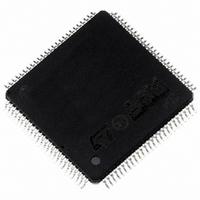ST92F150CV1TB STMicroelectronics, ST92F150CV1TB Datasheet - Page 222

ST92F150CV1TB
Manufacturer Part Number
ST92F150CV1TB
Description
MCU 8BIT 128K FLASH 100TQFP
Manufacturer
STMicroelectronics
Series
ST9r
Datasheet
1.ST92F150CV1TB.pdf
(429 pages)
Specifications of ST92F150CV1TB
Core Processor
ST9
Core Size
8/16-Bit
Speed
24MHz
Connectivity
CAN, EBI/EMI, I²C, LIN, SCI, SPI
Peripherals
DMA, LVD, POR, PWM, WDT
Number Of I /o
77
Program Memory Size
128KB (128K x 8)
Program Memory Type
FLASH
Eeprom Size
1K x 8
Ram Size
4K x 8
Voltage - Supply (vcc/vdd)
4.5 V ~ 5.5 V
Data Converters
A/D 16x10b
Oscillator Type
Internal
Operating Temperature
-40°C ~ 105°C
Package / Case
100-TQFP, 100-VQFP
Processor Series
ST92F15x
Core
ST9
Data Bus Width
8 bit, 16 bit
Data Ram Size
6 KB
Interface Type
CAN, I2C, SCI, SPI
Maximum Clock Frequency
24 MHz
Number Of Programmable I/os
80
Number Of Timers
5 x 16 bit
Operating Supply Voltage
4.5 V to 5.5 V
Maximum Operating Temperature
+ 105 C
Mounting Style
SMD/SMT
Development Tools By Supplier
ST92F150-EPB
Minimum Operating Temperature
- 40 C
On-chip Adc
16 bit x 10 bit
Lead Free Status / RoHS Status
Lead free / RoHS Compliant
Other names
497-4883
Available stocks
Company
Part Number
Manufacturer
Quantity
Price
Company:
Part Number:
ST92F150CV1TB
Manufacturer:
STMicroelectronics
Quantity:
10 000
- Current page: 222 of 429
- Download datasheet (8Mb)
MULTIPROTOCOL SERIAL COMMUNICATIONS INTERFACE (SCI-M)
MULTIPROTOCOL SERIAL COMMUNICATIONS INTERFACE (Cont’d)
10.5.8 Input Signals
SIN: Serial Data Input. This pin is the serial data
input to the SCI receiver shift register.
TXCLK: External Transmitter Clock Input. This
pin is the external input clock driving the SCI trans-
mitter. The TXCLK frequency must be greater than
or equal to 16 times the transmitter data rate (de-
pending whether the X16 or the X1 clock have
been selected). A 50% duty cycle is required for
this input and must have a period of at least twice
INTCLK. The use of the TXCLK pin is optional.
RXCLK: External Receiver Clock Input. This in-
put is the clock to the SCI receiver when using an
external clock source connected to the baud rate
generator. INTCLK is normally the clock source. A
50% duty cycle is required for this input and must
have a period of at least twice INTCLK. Use of RX-
CLK is optional.
DCD: Data Carrier Detect. This input is enabled
only in Synchronous mode; it works as a gate for
the RXCLK clock and informs the MCU that an
emitting device is transmitting a synchronous
frame. The active level can be programmed as 1
or 0 and must be provided at least one INTCLK pe-
riod before the first active edge of the input clock.
10.5.9 Output Signals
SOUT: Serial Data Output. This Alternate Func-
tion output signal is the serial data output for the
SCI transmitter in all operating modes.
CLKOUT: Clock Output. The alternate Function
of this pin outputs either the data clock from the
transmitter in Serial Expansion or Synchronous
modes, or the clock output from the Baud Rate
Generator. In Serial expansion mode it will clock
Figure 115. Receiver and Transmitter Clock Frequencies
Note: The internal receiver and transmitter clocks
are the ones applied to the Tx and Rx shift regis-
ters (see
222/429
9
Receiver Clock Frequency
Transmitter Clock Frequency
Figure
106).
External RXCLK
Internal Receiver Clock
External TXCLK
Internal Transmitter Clock
only the data portion of the frame and its stand-by
state is high: data is valid on the rising edge of the
clock. Even in Synchronous mode CLKOUT will
only clock the data portion of the frame, but the
stand-by level and active edge polarity are pro-
grammable by the user.
When Synchronous mode is disabled (SMEN in
SICR is reset), the state of the XTCLK and OCLK
bits in CCR determine the source of CLKOUT; '11'
enables the Serial Expansion Mode.
When the Synchronous mode is enabled (SMEN
in SICR is set), the state of the XTCLK and OCLK
bits in CCR determine the source of CLKOUT; '00'
disables it for PLM applications.
RTS: Request To Send. This output Alternate
Function is only enabled in Synchronous mode; it
becomes active when the Least Significant Bit of
the data frame is sent to the Serial Output Pin
(SOUT) and indicates to the target device that the
MCU is about to send a synchronous frame; it re-
turns to its stand-by value just after the last active
edge of CLKOUT (MSB transmitted). The active
level can be programmed high or low.
SDS: Synchronous Data Strobe. This output Al-
ternate function is only enabled in Synchronous
mode; it becomes active high when the Least Sig-
nificant Bit is sent to the Serial Output Pins
(SOUT) and indicates to the target device that the
MCU is about to send the first bit for each synchro-
nous frame. It is active high on the first bit and it is
low for all the rest of the frame. The active level
can not be programmed.
Min
0
0
0
0
0
0
0
0
INTCLK/8
INTCLK/4
INTCLK/8
INTCLK/2
INTCLK/8
INTCLK/4
INTCLK/8
INTCLK/2
Max
Conditions
16x mode
16x mode
16x mode
16x mode
1x mode
1x mode
1x mode
1x mode
Related parts for ST92F150CV1TB
Image
Part Number
Description
Manufacturer
Datasheet
Request
R

Part Number:
Description:
BOARD PROGRAM FOR ST92F150 MCU
Manufacturer:
STMicroelectronics
Datasheet:

Part Number:
Description:
BOARD EVALUATION FOR ST9 SERIES
Manufacturer:
STMicroelectronics
Datasheet:

Part Number:
Description:
BOARD EMULATOR FOR ST9 SERIES
Manufacturer:
STMicroelectronics
Datasheet:

Part Number:
Description:
MCU, MPU & DSP Development Tools ST9 Dedication Board
Manufacturer:
STMicroelectronics
Datasheet:

Part Number:
Description:
STMicroelectronics [RIPPLE-CARRY BINARY COUNTER/DIVIDERS]
Manufacturer:
STMicroelectronics
Datasheet:

Part Number:
Description:
STMicroelectronics [LIQUID-CRYSTAL DISPLAY DRIVERS]
Manufacturer:
STMicroelectronics
Datasheet:

Part Number:
Description:
BOARD EVAL FOR MEMS SENSORS
Manufacturer:
STMicroelectronics
Datasheet:

Part Number:
Description:
NPN TRANSISTOR POWER MODULE
Manufacturer:
STMicroelectronics
Datasheet:

Part Number:
Description:
TURBOSWITCH ULTRA-FAST HIGH VOLTAGE DIODE
Manufacturer:
STMicroelectronics
Datasheet:

Part Number:
Description:
Manufacturer:
STMicroelectronics
Datasheet:

Part Number:
Description:
DIODE / SCR MODULE
Manufacturer:
STMicroelectronics
Datasheet:

Part Number:
Description:
DIODE / SCR MODULE
Manufacturer:
STMicroelectronics
Datasheet:











